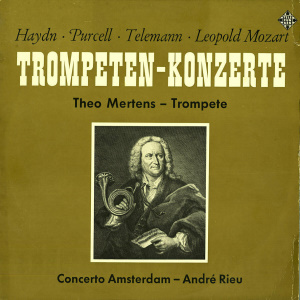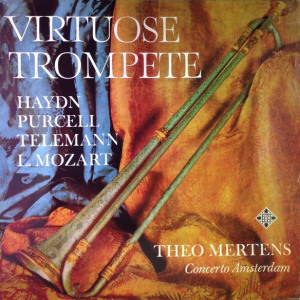 |
|
1 LP -
SLT 43091 - (p) 1965
|
 |
| 1 LP -
6.41145 AW - (p) 1965 |
 |
| 1 LP -
6.41145 AH - (c) 1982 |
 |
| 1 CD -
8.44079 XG - (c) 1988 |
|
| TROMPETEN-KONZERTE |
|
|
|
|
|
|
|
| Joseph HAYDN (1732-1809) |
Konzert
für Trompete und Orchester Es-dur,
Hoboken VII e Nr. 1 |
|
14' 36" |
|
|
-
Allegro
|
6' 09" |
|
A1 |
|
-
Andante
|
3' 25" |
|
A2 |
|
-
Finale - Allegro |
5' 02" |
|
A3 |
| Henry PURCELL (1659-1695)
|
Sonata für Trompete, Streicher
und Continuo |
|
5' 23" |
|
|
-
(Allegro) |
1' 27" |
|
A4 |
|
-
Adagio |
1' 43" |
|
A5 |
|
-
(Allegro) |
2' 06" |
|
A6 |
| Leopold MOZART (1719-1787) |
Konzert
für Trompete, Hörner, Streicher und
Basso continuo D-dur |
|
12' 49" |
|
|
-
Adagio |
7' 31" |
|
B1 |
|
-
Allegro moderato |
5' 18" |
|
B2 |
| Goerg Philipp
TELEMANN (1681-1767) |
Konzert
für Trompete, Streicher und Basso
continuo D-dur |
|
7' 17" |
|
|
-
Adagio |
1' 35" |
|
B3 |
|
-
Allegro |
2' 10" |
|
B4 |
|
-
Grave |
1' 46" |
|
B5 |
|
-
Allegro |
1' 46" |
|
B6 |
|
|
|
|
|
|
CONCERTO AMSTERDAM
Jaap Schröder, Konzertmeister
Theo Mertensr, Trompete
Aneke Uittenbosch, Cembalo (Haydn, Purcell)
Gustav Leonhardt, Cembalo (L.Mozart, Telemann)
André RIEU, Dirigent
|
|
|
|
|
|
Luogo
e data di registrazione |
|
(luogo di
registrazione non indicato) - 1965
|
|
|
Registrazione:
live / studio |
|
studio |
|
|
Producer |
|
-
|
|
|
Prima Edizione
LP |
|
Telefunken | SLT
43091 (Stereo) | 1 LP - durata 40'
29" | (p) 1965 | ANA
Telefunken
| 6.41145 AW | 1 LP durata 40'
29" | (p) 1965 | ANA |
Riedizione
Telefunken
"Aspekte" | 6.41145 AH | 1 LP
durata 40' 29" | (c) 1982 | ANA
| Riedizione |
|
|
Edizione CD |
|
Teldec "I Love
Classics" | 8.44079 HG | 1 CD -
durata 40' 29" | (p) 1965 | AAD |
|
|
Cover
|
|
"Gottfried Reiche",
Kupferstich von Rosbach nach dem
Gemälde von G. Hausmann.
|
|
|
Note |
|
Gustav Leonhardt
appears only in the compositions
of Leopold Mozart and Telemann.
|
|
|
|
|
The works
recorded on this disc do not
only comprise a selection of
better and lesser known
items from the concerto
repertoire; they provide at
the same time an instructive
survey of the development of
the trumpet concerto in
musical history, from in
early baroque beginnings to
the classical period.
Joseph Haydn (1732-1809)
wrote only one trumpet
concerto, that in E flat
major (Hokoken VII, e, No.
1). It is at the same time
the last orchestral work of
this great classical master,
composed in 1796, after his
second visit to England. It
is dedicated to the Viennese
court trumpeter Anton
Weidlinger, who in the
seventeen-nineties occupied
himself with the development
of a keyed trumpet, and
sought a suitable concerto
for his high trumpet in E
flat.
This work in three movements
also provides the solo
instrument with plenty of
opportunity for displaying
its virtuosity. The first
movement is in sonata form.
The second, in ternary form,
lets the trumpet develop its
possibilities of cantabile
playing. The Rondo-Finale,
on the other hand, places
the virtuoso solo element
decidedly in the foreground,
yet without disturbing the
well-balanced classicism of
this late work of the
composer.
Henry Purcell (1659-1695)
is the greatest English
master of the early baroque
period. He enjoyed no mean
reputation in his day, not
only as a composer but also
as a musical theorist, and
he prefaced his Twelve Trio
Sonata published in 1683
with a "Foreword to the
Reader" that gives us
important basic information
about his instrumental
writing. We find these words
in it: "It was the
author's sincere endeavour
to imitate the most famous
Italian masters, above all
to help the earnestness and
dignity of this kind of
music to gain popularity and
esteem among our people".
The three-movement "Sonata
for Trumpet and Strings" is
a typical example of the
adoption of Italian forms of
music making that were
developed in the early
seventeenth century.
Purcell, however, who had a
fine ear for harmony and an
original sense of the
essence of polyphony, here
demonstrates an individual
transformation of the
Italian models, so that his
early baroque "pre-fugal"
style and the many motif
imitations that appear
already anticipate the world
of Bach and Handel.
The first movement is a
lively piece of
'concertante' music making,
its most striking feature
being the alternating play
of motifs between the solo
instrument and the strings.
In the second movement
(Adagio) the trumpet is
silent, the homophonic piece
in B minor being played by
the strings alone. The
Finale is a disguised dance
movement in 3/8 time. The
main theme, which enters in
canon, is soon joined by a
second, contrasting idea
characterized by repeated
notes. The movement closes
with a fanfare typical of
the solo instrument.
In his "Report on the
Present State of the Music
of His High Princely Grace
the Archbishop of Salzburg",
written in 1757, Leopold
Mozart (1719-1787)
relates that during
hisactivities as "Court and
Chamber Composer" he had
composed a large number of
"Symphonies, thirty large
Serenades" and also "many
Concertos, particularly for
the Transverse Flute, Oboe,
the Bassoon, Horn, the
Trumpet etc.".
The Trumpet Concerto in D
major heard on this record
must be regarded as one of
them master's many
"occasional" compositions;
its solo part was probably
played by Andreas Schachtner
on the occasion of a court
concert. Schachtner was a
friend of the Mozart family,
and Leopold praises his
"fine trumpet" and the fact
that he knew how to play
"with good taste".
The two-movement work begins
with an Adagio, whose
conventional main theme is
an embellished scale figure.
There is no proper second
theme, and thus the A major
episode only has a
modulatory character. The
thoroughly homophonic
writing lets the trumpet
part stand out as a main
impression, as a song-like
melody full of feeling
which, according to the
prevailing aesthetics, was
to sound "touching, emphatic
and sublime" (Scheibe:
"Kritischer Musikus").
The Allegro is a typical
divertimento movement. Its
echo effects recall the
"terraced" dynamics of the
baroque age, while the main
theme with its sequence of
triads and its note
repetitions is based on the
early classical Italian
opera overture. Thus this
carefree, easy-to-follow
trumpet concerto can be
identified as 'utilitarian'
music of its age, also
providing a document of
Leopold's style of
composition, which is
characterized by a
predeliction for the
"popular".
Georg Philipp Telemann
(1681-1767) is one of
the most universal musical
personalities of the
eighteenth century, and the
gramophone record has played
a decisive part in the
revival of his works. A
great number of compositions
by this extraordinarily
prolific and versatile
representative of high
baroque musical culture are
still awaiting discovery and
re-performance. Telemann was
a musical 'grand seigneur',
a highly educated man of the
world who had visited many
of the countries of Europe
and mastered many foreign
languages. From the German
tradition he derived the
contrapuntal mode of
writing, from the Italians
he adopted the song-like
quality of their melody,
from the French the 'galant'
style and their colourful
harmony. On his travels he
made the acquaintance of the
folk-music of various
countries, as the result of
which Slavonic rhythms in
particular have found their
way into his music. The
manner in which Telemann has
brought about a synthesis of
these differing styles is
truly daring; in addition,
there is hardly any type of
composition at which
Telemann has not tried his
hand.
The four-movement trumpet
concerto recorded here is
similar in structure to the
large-scale form of the
church sonata, with a
sequence of movements
slow-quick. As regards the
instrumentation, the work
belongs to the category of
the triple concerto, the
virtuoso character of the
trumpet part causing it to
predominate in the solo
group. Each of the four
movements of this
spontaneous piece of music
making captivates the
listener through its
richness of expression,
characteristic depiction of
emotions and supreme mastery
of writing.
Günter
Schneider
Theo Mertens was born on
February 10th, 1932, at
Boechout near Antwerp in
Belgium. From the age of
eleven he took
trumpet-lessons with the
well-known pedagogue Emiel
Maes and soon began a career
as a child prodigy. By the
time he was 18 he had
already distinguished
himself in winning high
musical honours, The Royal
Flemish Concervatory of
Music, where he began as a
pupil, has now won him as a
member of its staff. In 1955
Theo Mertens was first prize
winner in the "Concours
International d'Exécution
Musicale" at Geneva, and
yjis was followed by a
series of concert tours
which took him all over the
world.
Theo Mertens repertoire
includes not only classical
but also modern music, and
the virtuosity of his style,
the neatness and elegance of
his technique, as also
musical sensitivity and the
golden sound of his tobe
give tise to praise and
admiration wherever he goes.
|
  |
|
|